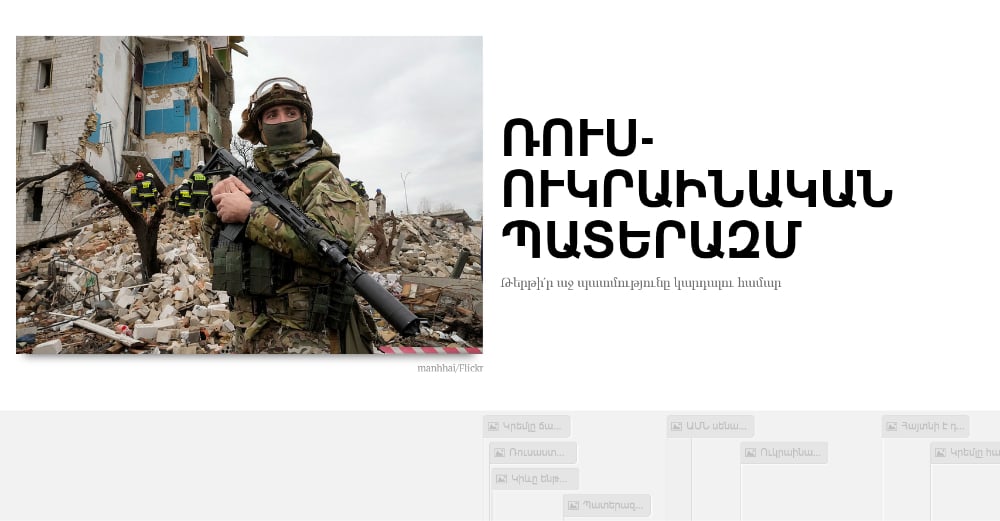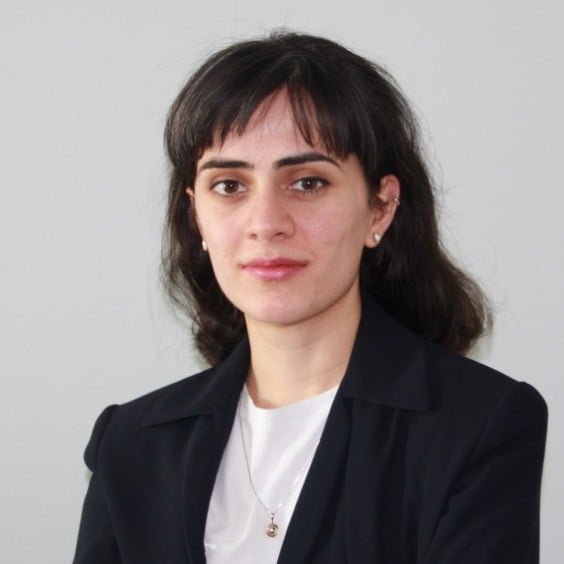
Over the last decade, once neighborly relations between Russia and Ukraine grew into animosity. Russia had the conflict roll into a full-scale war, which quashed the security system in the Europe. The ever-changing and often way too dangerous geopolitical advancements have direct implications for our region likewise. To this end, Media.am has put together all the crucial happenings we need to know about this war along three imagery timelines.
In 1990-ies, following the collapse of the USSR, Russia and Ukraine started forging friendly relations. And in December 1991, the leaders of Russia, Ukraine and Belarus founded the CIS later joined by Armenia likewise. It was in 1994 that Ukraine gave up significant reserves of the nuclear weaponry inherited from the former USSR, in exchange for security warrants, one of the warrantors being Russia itself.
However, back then palpable differences between the politics of the two countries were already apparent. Like many other post-Soviet countries, Ukraine too was putting efforts to run multi-vector politics in an attempt to balance the Russian and Western influences. Despite the deep-rooted economic, political and cultural ties with Russia, Ukraine did not adhere to the idea of the Union State instigated by Russia and Belarus. At the same time, public support for the idea of integrating with the West was increasingly gaining traction. The Ukrainian Orange Revolution of 2004 did not give a chance to the pro-Russian candidate Viktor Yanukovych to become the President of the country. Eventually, Yanukovych got elected as a President only six years after the revolution.
At a Bucharest NATO summit of April 2008, the US President George Bush urged to welcome Ukraine and Georgia into the Western defense alliance. Russia was strongly opposed to it; Ukraine played too vital a role for the Kremlin, hence Moscow viewed Ukraine’s potential membership to NATO as a direct security threat of its own. The process ended up with Germany and France thwarting the US recommendation. Ukraine and Georgia were promised a membership with no clear dates. Years later, Russia will explain its aggression with its very wish to suspend NATO’s expansion.
Back in 2013, the administration of Yanukovych was about to sign the Association Agreement with the European Union. Armenia, too, had taken the path of signing a similar agreement with the EU. And just as Armenia snappily declared about not signing that document, similarly the Ukrainians put a hold on the process shortly after publishing the Agreement in the Government website. In both cases, the underlying reason was the same – the pressure from Kremlin. This decision unforeseen at that time didn’t embark on profound changes; the administration of Serzh Sarkissian carried on the multi-vector politics and ended up signing the EU Association Agreement in 2017. In the meanwhile, the breaking news on revoking the Agreement and the upcoming rapprochement with Russia instantaneously fomented far-ranging protests in Ukraine setting Euromaidan in motion.
The demonstrations lasting from November 2013 all the way through February 2014 lead to the resignation of Yanukovych once again reshuffling Moscow-Kyiv relations.
Timeline 1. Euromaidan
Vladimir Putin, who took the post of the Russian President for the third time in 2012, was gradually tightening the civil freedoms in the country on the one hand, while aggravating the relations with the western neighbors on the other hand.
The happenings in Ukraine dramatically intensified this tension, as this was a challenge for the Kremlin and implied an abrupt dwindling of Russian influence in the region.
It didn’t take long before Moscow blew a hit. Since the change of power in Kyiv was not univocally accepted by the population of the Eastern parts of the country, Russia managed to mobilize the Russian-speaking population of Crimea in just a few weeks’ time and taking the advantage of the destabilized Kyiv’s power, to annex the peninsula to Russia.
In March 16, a referendum was organized in Crimea by Russia and the residents voted for acceding to Russia. The results of this referendum have not been recognized by the international community to this day.
Soon afterwards Moscow declared about accepting Crimea into Russia. All these were accompanied by a large-scale campaign within Russia: Putin had been using the annexation of Crimea to stir anti-western flares and to improve his own rating.
In addition to the annexation of Crimea, Russia started to support the groupings from Donetsk and Lugansk regions (jointly often referred to as Donbas) wishing to secede from Ukraine. All these served as a starting point for the armed conflict between two countries.
Timeline 2. War in Donbas
While the Russian-Ukrainian border was witnessing regular shootings, Vladimir Putin’s power in Russia was increasingly getting stronger every day. The Kremlin set off a trove of persecutions of civil society and independent mass media. Political opponents of Putin were persecuted too: there was an assassination attempt by the special services on the opposition leader Alexei Navalny.
President Putin all the while was refusing to view Ukraine as a separate country carrying forward the story about Ukraine being historically a part of Russia. This was popular belief across Russia; Ukrainians were basically received as a “fraternal nation” and viewed not as a separate nation or state, but rather as an inseparable part of Russia and Russian culture.
In 2021, the sluggish and crawling peace process was derailed: around autumn Russia began hoarding forces along the Ukrainian border. In the meanwhile, Putin Government required guarantees that NATO would not expand towards East engaging Ukraine along the way. NATO member states declined it.
Despite the thriving edginess, various analysts and experts were unsure about Putin’s launch of an actual attack seeing what was happening simply as a muscle show over the course of negotiations. Conversely, the official sources of the USA and the Great Britain conveyed assurance about the attack to takeoff in the second half of February. To the dismay of many, on February 24, 2022, Russia attacked Ukraine and broke the war that lingers to this day.
Timeline 3. 2022 Russian-Ukrainian war
Karine Ghazaryan
Links used for timelines:
- DW.com, Украина приостановила процесс ассоциации с ЕС
- Forbes.ru, «Беркут» против евромайдана: фоторепортаж из Киева
- LB.ua, На Майдане выступили “Океан Эльзы” в оригинальном составе
- BBC.com, Путин обещает Украине скидку на газ и 15 млрд долларов
- BBC.com, Украинская Рада “вручную” приняла ряд спорных законов
- Ozodi.org, Верховная Рада отменила “диктаторские” законы
- BBC.com, Противостояние с “Беркутом” в Киеве: трое погибших
- Ukraine-memorial.org, Нигоян Сергей Гагикович
- 44.ua, Массовые убийства на Майдане 18-20 февраля 2014 года: как все было
- Pravda.com.ua, Люди поставили ультиматум: отставка Януковича до утра
- DW.com, Верховная рада отстранила Януковича от власти
- BBC.com, Янукович назвал события на Украине госпереворотом
- Kremlin.ru, Договор между Российской Федерацией и Республикой Крым о принятии в Российскую Федерацию Республики Крым и образовании в составе Российской Федерации новых субъектов
- RBC.ru, Беспорядки на востоке Украины: митингующие захватили оружие СБУ
- Svoboda.org, “Утка” дня. Донецкая народная республика
- DW.com, Сепаратисты в Харькове объявили о создании “народной республики”
- Kommersant.ru, Александр Турчинов подписал указ о начале спецоперации на востоке Украины
- Bellingcat.com, MH17 – The Open Source Evidence
- 1tv.ru, Ополченцы окончательно взяли под контроль Иловайск и его окрестности
- OSCE.org, Протокол по итогам консультаций Трехсторонней контактной группы относительно совместных шагов, направленных на имплементацию Мирного плана Президента Украина П. Порошенко и инициатив Президента России В. Путина
- OSCE.org, Комплекс мер по выполнению минских соглашений
- Whitehouse.gov, Fact Sheet: United States Imposes First Tranche of Swift and Severe Costs on Russia
- BBC.com, Удары России по Киеву и стрельба в городе. Что известно о ситуации на Украине к утру 25 февраля
- NPR.org, Russian troops leaving Kyiv area as Moscow focuses more on eastern Ukraine
- Media.am, Բուչան «բեմադրված էր», Վիննիցան անտեսվեց․ ի՞նչպես է հայկական Տելեգրամը լուսաբանում ռուս-ուկրաինական պատերազմը
- Reuters.com, After delay, U.S. Senate overwhelmingly approves $40 billion in Ukraine aid
- Apnews.com, Biden says US sending medium-range rocket systems to Ukraine
- Meduza.io, HIMARS — западные ракетные системы, с помощью которых Украина лишает Россию ключевого преимущества последних месяцев. Может ли российская армия что-то им противопоставить?
- Azatutyun.am, «Պատմական պահ». Ուկրաինան և Մոլդովան՝ ԵՄ անդամ երկրների թեկնածուներ
- Kyivpost.com, Ukrainian Counteroffensive Underway in Kherson Region
- Kremlin.ru, Указ «Об объявлении частичной мобилизации в Российской Федерации»
- BBC.com,“Гуманитарная катастрофа”. Как бегущие от мобилизации провели неделю в пробках на границах России
- BBC.com, Россия сдала Херсон. Как войска покидают оккупированные территории?
- Vox.com, Can Ukraine’s infrastructure survive the winter?


Add new comment
Comments by Media.am readers become public after moderation. We urge our readers not to leave anonymous comments. It’s always nice to know with whom one is speaking.
We do not publish comments that contain profanities, non-normative lexicon, personal attacks or threats. We do not publish comments that spread hate.